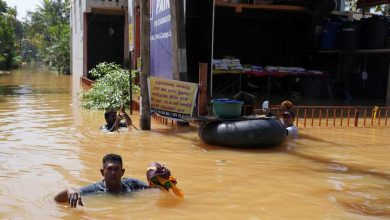HOW CAN SOCIETY OVERCOME COVID-19?
How society can overcome covid-19
Countries can test, quarantine and prepare for the post-coronavirus world, says Larry Brilliant, an epidemiologist
WHEN THE makers of the film “Contagion” in 2011 needed to vet the plausibility of the script, they turned to Larry Brilliant, one of the world’s leading epidemiologists. His reply scared them even more than the screenplay: not only was the scenario possible, he explained, it was almost certain to happen. Today, the world is living a nightmare similar to the cinematic description.
Mr Brilliant’s career stretches from living in an ashram in India and helping to eradicate smallpox with the World Health Organisation to co-founding the Seva Foundation to treat eye disease in poor countries. Around a decade ago he led Google’s philanthropic efforts (including being a co-author of a landmark paper in 2009 that applied artificial intelligence to epidemiology).
He has been warning the world about the threat of pandemics for years; today his voice on how to respond is indispensable. The Economist’s technology podcast, Babbage, interviewed Mr Brilliant on April 1st. Below is an edited transcript of the conversation, along with a link to the episode.
* * *
The Economist: For years you have warned about the possibility of a new global pandemic. Has covid-19 emerged in the way that you predicted?
Larry Brilliant: Sadly, yes. There’s no credit for predicting this. In fact, probably 30 or 50 or all the infectious-disease epidemiologists in the world predicted this almost precisely.
The Economist: Had we done enough to prepare for it?
Mr Brilliant: A number of things have been done all over the world that have made it possible to have “speed bumps” in the path of this virus. We have a wonderful collection of digital disease-surveillance networks: “Flu near you”; “Covid near you”; the Canadian system. Various countries have phenomenal systems, Thailand, especially. Bi-directional systems.

So I think that you’ll see that different countries will have better luck responding to the pandemic, because they’ve detected it sooner; responded quicker. And in those countries you will find they have better surveillance systems, many of them digital. Some, like in Cambodia, [have] an analogue system, a phone-in system where all Cambodians report their diseases faster than almost any other place in the world. That is a legacy of a group called Ending Pandemics, which is run by my colleague, Mark Smolinski.
[But] if you’re saying “governments have failed in their response”—that, I would agree with you. And there are a series of reasons for that.
The Economist: Many countries are dealing with this, but do we understand the full scale of this pandemic yet?
Mr Brilliant: No. There are eight billion of us, plus or minus. This is a novel virus that came from animals, most likely from a bat or some intermediate animal. A novel virus, by its name, can infect every susceptible person in the world. That means all eight billion of us are susceptible to this virus under the “right”—or should I say, under the “wrong”—circumstances.
I would add, also, the rate of speed of this virus, in terms of its transmissibility or its R0 (“R-naught”) and the interval or incubation period. The rate of speed is governed by those two things: that rate of transmissibility (the short or longness of the incubation period), and the generational interval. But it is mostly dictated by the “density of susceptibles”. If, in fact, you have a virus that should be transmitting 12 new cases for each one, like measles, but if 100% of the people are vaccinated, well, that R0 value goes down to zero.
The Economist: How does covid-19 compare to other diseases you’ve fought, like smallpox or polio?
Mr Brilliant: Well, smallpox has an R0 of three-and-a-half to four-and-a-half, which means that for every one case of smallpox in the wild, there will be three-and-a-half or four-and-a-half new people who get it. The average flu’s R0 value is about 1.2 or 1.3 or 1.1. The great influenza in 1918 probably had an R0 of a little over 2 or a little under 2. This virus so far we believe to have an R0, or a transmissible value, of between 2.2 and 2.4. So it’s a lot faster, a lot worse than ordinary flu. A little less than smallpox, a lot less than measles.
The Economist: What do you think needs to be done to reduce the transmission of covid-19?
Mr Brilliant: Oh, that’s a perfect question. That is the key question. You must reduce the density of susceptibles. Again, if 100% of the people were vaccinated, the R0, the transmissibility, would go down to zero. It doesn’t matter its potential transmissibility. If everybody around a virus was quarantined, and the person who had the virus was quarantined, and there could be no contact between them, the transmissibility would go down to zero.
That is the entire reason behind quarantine. And it is the derivative reason behind social distancing. As we are good at social distancing, the transmissibility goes down. If we create a laissez-faire transmissibility, or a Swiss cheese-like transmissibility with holes in it—with people going to beach parties, while everybody else is at home with a mask and gloves and huddled in the backroom—those holes will lead to increasing transmissibility.
The Economist: Do you believe governments are taking the outbreak seriously enough?
Mr Brilliant: So today is April Fools’ Day. I hate to make a comparison between the date and the answer to your question. I would say that governments have been incredibly slow in responding, almost without exception. I think that your government in the UK […] began on a misguided mission to allow or think that they could allow everybody or a large number of people to become infected, in an effort to reach the epidemiologist’s Holy Grail of “herd immunity”.
I think my government [in America] fumbled, almost unforgivably, in the way they mangled the distribution of test kits; in the way that our leadership pretended that the outbreak could be brought down from five to zero and it would not be a problem after a while. And it continued to underplay how important it was, as “a hoax,” until finally confronted with the stark reality.
I think Germany has responded quickly. I think South Korea, after fumbling a little bit in the early days, came down extremely well. And despite a little reversal a few days ago, it has really shown itself a model for what other countries can do.
And of course China, which I think delayed—or maybe because of a regional government—delayed for almost a month. But once they understood what it was, they came down with what is called “draconian” methods. People say the West can follow them: we don’t need to be draconian, but we can follow the methods.
The Economist: Do you believe a vaccine will be found and if so, how quickly? And what are the alternative options in the meantime?
Mr Brilliant: I see no reason to not believe that a vaccine will be found. While we weren’t successful In making the vaccine after the first SARS or MERS outbreaks, that was just because the epidemic was over so quickly that we didn’t keep a sustained effort. There is nothing biologically that I see in the virus that troubles me. We already do have putative or potential vaccines.
I think we will have a vaccine that works in less than a couple of months. Then it will be the arduous process of making sure that it is effective enough and that it is not harmful. And then we have to produce it. [The director of America’s National Institute of Allergy and Infectious Diseases] Tony Fauci’s estimate of 12 to 18 months before we have a vaccine, in sufficient quantities in place, is one that I agree with.
I just want to mention, once we have that vaccine, and we’ve mass vaccinated as many people as we could, there will still be outbreaks. People are not adding on to the backend of that time period the fact that we will then be chasing outbreaks, ping-pong-ing back and forth between countries. We will need to have the equivalent of the polio-eradication programme or the smallpox-eradication programme, hopefully at the WHO. And that mop-up—I hate to use that word when we’re talking about human beings—but that follow-on effort will take an additional period of time before we are truly safe.
The Economist: What are the alternative options in the meantime?
Mr Brilliant: Well, there are a couple. One in the medium-term is an antiviral to treat people and make them well quicker so they shed virus sooner. I think we’re doing really well with antivirals. WHO has embarked on a multi-country, multi-agent trial of five possible therapies, and I believe they’ve enrolled 20,000 people so far. Once that is concluded we’ll know whether any of those five work. If they don’t, we’ll continue doing more and more trials. In fact, every country is doing trials of favourite candidates and I’m confident we will find an antiviral.
Now comes the question: will we be able to find an antiviral like Tamiflu, that has vaccine-like attributes? In other words, when you use Tamiflu, you use it to treat yourself. But your wonderful Neil Ferguson, [an epidemiologist at Imperial College London], showed in 2005 in an article in Nature that you could actually saturate an entire city’s population with Tamiflu if that city had bird flu. And you could use it because it did have possibilities that it could be used like a vaccine. Now, we’ve never done this on a large scale. But that is another possibility.
Absent that and absent a vaccine, the only possibility that we have in our tool-kit is personal hygiene—washing your hands 20 seconds, singing “Hail to the Queen” twice—and then wearing masks, gloves, making sure you’re taking yourself out of the density-of-susceptibles category, and then adding on social distancing and maintaining that for several incubation periods.
The Economist: In your time, you have seen pandemics subside. What does a return to normality look like? Life after covid-19?
Mr Brilliant: It’s going to be hard. You know, first, during the peak of this pandemic, we will see things that my generation, your generation, has never seen before. When I was in India—and I lived in India for 10 years; I love India—working on the smallpox eradication programme, in the year that we began the programme, there were 250,000 children who were stricken with disease. At least a third would die, perhaps more. And the crematoriums were unable to handle the load. So you would find bodies wrapped in paper cloth that would be stacked like cords of wood.
We are not able to look at a scene like that, like Dante’s Inferno or Hieronymus Bosch’s paintings. We’re not able to look at that without feeling something that we don’t feel for almost anything else in the world. We’ll look at that; we’ll look at the way that we see wonderful, good people—shopkeepers and workers—who are made homeless. We will go back to a time and a state that we’re not ready for emotionally.
And when my colleagues and I have talked over the last 30 years, or we’ve done in the movie “Contagion,” we’ve tried to show that it isn’t just the biology of the virus that causes such great social disruption. It’s the knock-on effects to human beings’ lives; their financial well-being, the familial bonds that are tested, are made strong. The way that the best of people or the worst of them come out during an epidemic like this. We will see ordinary people become saints; we will see ordinary people become criminals. We’re not prepared for it.
And so the end of that, first, will be disbelief; bewilderment. And the return to normality will be slow.
I add also, of course, throughout history pandemics, like rivers, recreate the boundaries of countries. And with the rising tide of nationalism that we’ve seen in the past few years, you give a tyrant or a dictator the power that is needed to conquer a pandemic, the question remains: What will they do with that power once it is not needed for the pandemic? Will they surrender it voluntarily and go back to democracies—or not?






